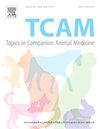选择性性腺切除术中出现的狗和猫隐睾:一项描述性队列研究,对2018年至2023年间治疗的306只动物进行了研究。
IF 1.3
3区 农林科学
Q2 VETERINARY SCIENCES
引用次数: 0
摘要
本研究的目的是描述选择性性腺切除术中犬和猫隐睾的发病率、品种分布、临床表现(解剖位置、受影响的睾丸数量和一侧)和手术处理。回顾性分析了2018-2023年一家非营利性、高容量、高质量的绝育诊所的病历摘要,其中包括隐睾犬和猫的选择性性腺切除术病例。在研究期间,5476只狗和11559只猫被送到同一机构进行选择性手术阉割,表明狗和猫的隐睾发生率分别为3.21%和1.12%。隐睾症影响各种品种和身体形态。隐睾在腹股沟区比腹部更常见,在狗和猫中更常位于单侧右侧。在狗和猫中,位于腹部的睾丸比位于腹股沟区域的睾丸需要手术治疗的平均总切口数量要高。由于解剖结构、隐睾患病率和手术技术的差异,狗和猫的隐睾应该分开评估。仔细地、预先地识别和定位保留的睾丸有助于有效地切除隐睾。本文章由计算机程序翻译,如有差异,请以英文原文为准。
Cryptorchidism in dogs and cats presented for elective gonadectomy: A descriptive cohort study of 306 animals treated between 2018 and 2023
The objective of this study was to describe the incidence, breed distribution, clinical findings (anatomic location, number of testicles affected, and side), and surgical management of cryptorchidism in dogs and cats presented for elective gonadectomy. Medical record abstracts from a non-profit, high-volume, high-quality, spay-neuter clinic from 2018 to 2023 were reviewed retrospectively for cases of elective surgical gonadectomy of cryptorchid dogs and cats. During the study period, 5,476 dogs and 11,559 cats were presented to the same facility for elective surgical castration, suggesting a cryptorchid incidence of 3.21 % for dogs and 1.12 % for cats. Cryptorchidism affects various breeds and body conformations. Cryptorchid testes were more commonly observed in the inguinal area than in the abdomen, and were more frequently located unilaterally on the right side in both dogs and cats. The mean number of overall incisions required for surgical management was higher for testes located in the abdomen than for those located in the inguinal region in both dogs and cats. Due to differences in anatomy, cryptorchid prevalence, and surgical techniques, cryptorchidism in dogs and cats should be evaluated separately. Careful, preemptive identification and localization of the retained testicle(s) can be beneficial for efficient excision of cryptorchid testes.
求助全文
通过发布文献求助,成功后即可免费获取论文全文。
去求助
来源期刊

Topics in companion animal medicine
农林科学-兽医学
CiteScore
2.30
自引率
0.00%
发文量
60
审稿时长
88 days
期刊介绍:
Published quarterly, Topics in Companion Animal Medicine is a peer-reviewed veterinary scientific journal dedicated to providing practitioners with the most recent advances in companion animal medicine. The journal publishes high quality original clinical research focusing on important topics in companion animal medicine.
 求助内容:
求助内容: 应助结果提醒方式:
应助结果提醒方式:


